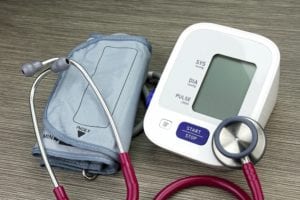Written by Chrystal Moulton, Staff Writer. Most significant changes in systolic and diastolic blood pressure were observed between 2-3g/d dosage of EPA plus DHA.
 Various trials researching the effects of omega-3 fatty acids have shown that they are safe and effective in reducing risk factors related to the development of cardiovascular disease 1,2. Although there are some positive effects, the effect of omega-3 intake on blood pressure is conflicting 3-5. Meta-analyses examining the association between omega-3 intake and blood pressure utilized methods that were prone to biases and do not include correlations at different dose levels. In the current meta-analysis 6, researchers evaluated the dose-response effect of EPA, DHA, and EPA + DHA in the general population.
Various trials researching the effects of omega-3 fatty acids have shown that they are safe and effective in reducing risk factors related to the development of cardiovascular disease 1,2. Although there are some positive effects, the effect of omega-3 intake on blood pressure is conflicting 3-5. Meta-analyses examining the association between omega-3 intake and blood pressure utilized methods that were prone to biases and do not include correlations at different dose levels. In the current meta-analysis 6, researchers evaluated the dose-response effect of EPA, DHA, and EPA + DHA in the general population.
Literary search for randomized controlled trials of either crossover or parallel design examining the association between EPA/DHA on blood pressure in adults was conducted. Studies evaluating EPA/DHA intake through diet and supplementation were accepted. Studies also needed to have follow-ups at multiple time points and focused on changes in blood pressure pre- and post-treatment. Data from eligible studies were put into a dose response curve. Effect of EPA/DHA was estimated at 1g/d, 2g/d, 3g/d, 4g/d, and 5g/d. additional analysis was done based on trial design (crossover v. parallel), the presence of hypertension, hyperlipidemia, age, and duration of treatment.
In total, 71 articles were eligible for this meta-analysis with a total sample size of 4973 participants (aged 22-86 years old). Average trial duration was 10weeks. Average combined dose of EPA/DHA used in 53 of 71 trials was 2.8g/d [11 trials reported DHA only (average: 1.4g/d) and 6 trials reported EPA only (average: 1.8g/d)]. Since there was not sufficient data to assess EPA or DHA alone in relation to blood pressure, results were focused on the combined supplementation of EPA and DHA. A significant dose-response curve was found for systolic blood pressure (P= 0.0001) and diastolic blood pressure (P= 0.0073). Based on the dose-response curve, the overall effective dose range for EPA plus DHA is between 0 to 5g/d. Within this range, the most significant changes in systolic and diastolic blood pressure were observed between 2-3g/d dosage of EPA plus DHA. For systolic blood pressure, data showed -2.61mmg/Hg average change for both 2 and 3g/d of EPA plus DHA supplementation. For diastolic blood pressure, data showed average -1.64mm/Hg for 2g/d EPA plus DHA and average -1.80mm/Hg change for 3g/d EPA plus DHA supplementation. Weaker associations were observed at combined doses above 3g/d EPA plus DHA. Subgroup analysis found that individuals with baseline hypertension (≥140mm/Hg) had greater improvement in systolic and diastolic blood pressure compared to those with healthy blood pressure (<140mm/Hg). Furthermore, patients 45years and older showed significant improvement in blood pressure compared to younger participants (<45years old) [dose range: 2-3g/d]. No significant differences were observed for gender or trial design. Analysis for publication bias showed that the results were not driven by a small number of studies rather the overall effect of all trials included in this study.
These findings suggest the optimal dose range for EPA plus DHA for improvement of blood pressure is between 2 and 3g/d. Based on findings, this dose would be most effective for individuals with hypertension who are over the age of 45years old. More studies will be needed to verify these findings.
Source: Zhang, Xin, Jennifer A. Ritonja, Na Zhou, Bingshu E. Chen, and Xinzhi Li. “Omega‐3 polyunsaturated fatty acids intake and blood pressure: a dose‐response meta‐analysis of randomized controlled trials.” Journal of the American Heart Association (2022): e025071.
© 2022 The Authors. Published on behalf of the American Heart Association, Inc., by Wiley. This is an open access article under the terms of the Creative Commons Attribution-NonCommercial-NoDerivs License, which permits use and distribution in any medium, provided the original work is properly cited, the use is non-commercial and no modifications or adaptations are made.
Click here to read the full text study.
Posted July 25, 2022.
Chrystal Moulton BA, PMP, is a 2008 graduate of the University of Illinois at Chicago. She graduated with a bachelor’s in psychology with a focus on premedical studies and is a licensed project manager. She currently resides in Indianapolis, IN.
References:
- Yokoyama M, Origasa H, Matsuzaki M, et al. Effects of eicosapentaenoic acid on major coronary events in hypercholesterolaemic patients (JELIS): a randomised open-label, blinded endpoint analysis. The Lancet. 369(9567):1090-1098. doi:http://dx.doi.org/10.1016/S0140-6736(07)60527-3
- Bhatt D. Reduction of Cardiovascular Events With Icosapent Ethyl–Intervention Trial – REDUCE-IT. 2018:
- Morris MC, Sacks F, Rosner B. Does fish oil lower blood pressure? A meta-analysis of controlled trials. Circulation. Aug 1993;88(2):523-33. doi:10.1161/01.cir.88.2.523
- Campbell F, Dickinson HO, Critchley JA, Ford GA, Bradburn M. A systematic review of fish-oil supplements for the prevention and treatment of hypertension. Eur J Prev Cardiol. Feb 2013;20(1):107-20. doi:10.1177/2047487312437056
- Miller PE, Van Elswyk M, Alexander DD. Long-chain omega-3 fatty acids eicosapentaenoic acid and docosahexaenoic acid and blood pressure: a meta-analysis of randomized controlled trials. Am J Hypertens. Jul 2014;27(7):885-96. doi:10.1093/ajh/hpu024
- Zhang X, Ritonja JA, Zhou N, Chen BE, Li X. Omega-3 Polyunsaturated Fatty Acids Intake and Blood Pressure: A Dose-Response Meta-Analysis of Randomized Controlled Trials. J Am Heart Assoc. Jun 7 2022;11(11):e025071. doi:10.1161/jaha.121.025071
